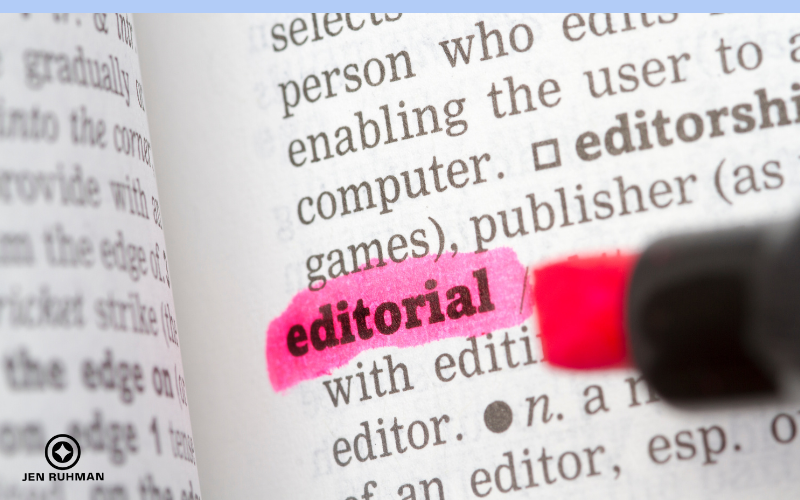When we delve into the realms of content creation and digital marketing, one term that frequently crops up is “editorial content.” But what exactly does this term entail? In this comprehensive guide, we’ll explore the nuances of editorial content, its significance, and how it stands apart from other types of content.

Defining Editorial Content
Understanding Editorial Content Editorial content can be broadly defined as any material in written, visual, or audio form that expresses opinions, insights, or provides in-depth information on a particular topic, subject, or issue.
Characteristics of Editorial Content
Opinionated and Insightful At its core, editorial content is characterized by its opinionated nature. It often reflects the viewpoints, beliefs, and values of the author or the publication’s editorial board.
Well-Researched and Informative Despite being opinionated, high-quality editorial content is always well-researched and backed by facts and evidence. This ensures that the content is not just a rant but an informed opinion that adds value to the reader.
Engages and Provokes Thought Editorial content aims to engage its audience, provoke thought, and initiate discussions. It encourages readers to reflect on issues, form their own opinions, and participate in broader conversations.
The Role of Editorial Content
Building Credibility and Trust Editorial content plays a crucial role in building the credibility and trustworthiness of a publication or a brand. By expressing opinions and providing well-researched insights, it establishes the author or brand as an authority in their field.
Influencing Public Opinion
Shaping Perceptions Through its opinionated nature, editorial content has the power to influence public opinion and shape perceptions on various issues.
Driving Change Beyond just influencing opinions, editorial content can also drive social, political, and economic changes by raising awareness, highlighting issues, and advocating for change.
Different Types of Editorial Content
Opinion Pieces and Commentaries These are pieces where authors express their personal opinions on topics. They are subjective but should still be grounded in facts and logical reasoning.
Analysis and Interpretation This involves providing in-depth analysis and interpretation of events, trends, or data. It goes beyond just reporting facts and adds value through expert insights and context.
Reviews and Critiques Editorial content also encompasses reviews and critiques of products, services, books, films, and more. These pieces provide evaluations based on the author’s experiences and criteria.
Creating Effective Editorial Content
Understanding Your Audience Knowing your audience is crucial when creating editorial content. Understanding their interests, beliefs, and values helps in crafting content that resonates with them.
Maintaining a Balance
Balancing Opinions and Facts While editorial content is opinionated, maintaining a balance between opinions and facts is essential. This ensures credibility and helps in building trust with your audience.
Avoiding Sensationalism It’s important to avoid sensationalism and hyperbole. Staying true to the facts, even while expressing opinions, ensures that the content is taken seriously and respected.
The Future of Editorial Content
Adapting to Changing Trends The world of content is ever-evolving, and editorial content is no exception. Adapting to changing trends, technologies, and audience preferences is key to staying relevant and effective.
Embracing New Formats and Channels
Expanding Beyond Text With the rise of video, podcasting, and other formats, editorial content is expanding beyond traditional text-based articles. Embracing these new formats and channels can help in reaching wider audiences and staying ahead in the content game.
Editorial content is a powerful tool in the arsenal of content creators and marketers. It builds credibility, influences opinions, engages audiences, and drives change. By understanding its nuances, characteristics, and role, and by creating high-quality, balanced, and engaging editorial content, we can leverage its full potential to connect with audiences, establish authority, and make a lasting impact.
FAQs
- What makes editorial content different from other types of content?
- Editorial content is opinionated, insightful, and aims to engage and provoke thought, making it distinct from other more straightforward, objective types of content.
- How does editorial content build credibility?
- By expressing informed opinions, providing insights, and establishing authority on topics, editorial content builds credibility and trust with audiences.
- Can editorial content be in formats other than text?
- Yes, editorial content is evolving to include video, audio, and other formats, expanding its reach and engagement.
- Is it important to balance opinions and facts in editorial content?
- Absolutely, maintaining a balance between opinions and facts is crucial in editorial content to ensure credibility and trustworthiness.
- How does editorial content influence public opinion?
- Through its opinionated nature and ability to engage audiences, editorial content has the power to shape perceptions and influence public opinion on various issues.
Do you want to boost your website’s visibility?
Optimizing your website for search engines is a proven strategy to attract more visitors. With our monthly SEO services, your website can climb the Google rankings, resulting in increased leads and sales.
At Jen Ruhman SEO, we’re one of the top SEO companies in San Diego – our goal is to aid in the online growth of your business. We are confident that an effective SEO plan can lead to substantial growth in both traffic and revenue. Recognized as a leading SEO firm in San Diego, CA, we are just a phone call away when you need our assistance.
Book a complimentary consultation with us today!

